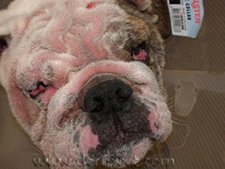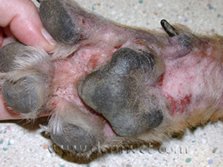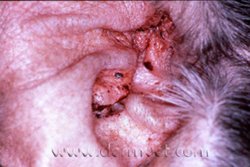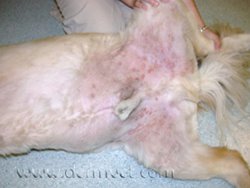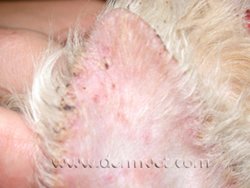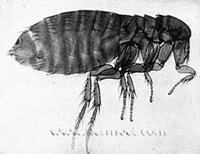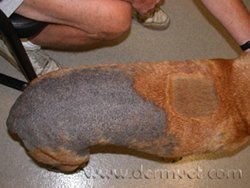Itching in Dogs
Skin problems are common in dogs and cats, and are one of the most frequent reasons that owners bring their pets to the veterinarian. There are many different reasons why a pet will itch and scratch. Fortunately, we can break most of the causes down into a few categories: allergies, skin parasites, and skin infections.
Allergies
-
Just like people, dogs, and cats can be allergic to pollen, dust, and molds. But instead of sneezing and hayfever, pets most often show their allergies in their skin. Allergic cats may develop crusty dermatitis or lick their hair so much that they cause bald spots. Allergic dogs may scratch all over, but especially at their armpits, belly, and ears. They may also have recurrent skin and ear infections and lick their paws. The signs usually start between 6 months to 5 years of age. Since food allergies and skin parasites or infections also cause itching, these diseases need to be eliminated as possible causes of itching before the diagnosis of atopy can be made. Some pets with pollen/dust allergies tend to have seasonal (warm weather) symptoms, while others may have symptoms year-round. Some pollen-allergic pets can be treated symptomatically during the itchy seasons with soothing shampoos/conditioners and anti-itch medications (antihistamines, fatty acids, occasional steroids). If present, secondary bacterial or yeast infections also need to be treated.
Pets with continuous signs or itch that are not well-controlled with symptomatic medications or that need steroids too frequently should be allergy tested to find out what they are allergic to. Allergy testing can be performed with blood tests or skin tests (like scratch testing in people). Blood allergy testing is more convenient and can be performed by most veterinarians, but may be less accurate than skin testing. Skin allergy testing tests the actual organ that is involved in the allergy (the skin), so is more accurate than blood testing and is typically performed by veterinary dermatologists. Once the allergy test results are known, allergic pets can receive allergy shots (just like people!) to desensitize them to the pollen.
Although not a cure or a quick fix, allergy hyposensitization injections help 70-75% of allergic pets to decrease symptoms and need for other medications, and address the cause of the allergies, not just the symptom.
-
Animals with food allergies can show very similar signs as pets with pollen allergies, but the itching is not seasonal and animals can develop a food allergy at any time in their life—even if they have been eating the same food all along! Cats may develop crusty dermatitis or hair loss similar to pollen allergy. Besides itchiness, food-allergic dogs may also have ear or skin infections. The symptoms of food allergy usually do not improve much with anti-itch medications, and the diagnosis and treatment is to feed the pet a hypoallergenic diet using a protein source that they have never been exposed to before. Switching to another commercial diet usually does not help, because most of these diets have similar ingredients. A better alternative is a hypoallergenic diet with single unique protein ingredients such as fish, rabbit, duck, or venison, with a single carbohydrate such as potato or rice, and no other treats, table scraps, rawhides, milk bones, chewable supplements, or other foods for at last 6-8 weeks. Some food-allergic dogs require home-cooked hypoallergenic diets. Blood or skin testing for food allergy is unfortunately not accurate in dogs and cats, and over-the-counter hypoallergenic diets may have ingredients not listed on the label (Click on this link for more information). If present, secondary bacterial or yeast infections also need to be treated. If the itchy symptoms have resolved in 6-8 weeks, new food allergens can be added one at a time every 2-3 weeks (ie. beef, chicken, lamb, wheat, corn, egg, milk, etc.) to determine what the pet is allergic to and what other foods they may tolerate.
Skin Parasites
-
Pets with continuous signs or itch that are not well-controlled with symptomatic medications or that need steroids too frequently should be allergy tested to find out what they are allergic to. Allergy testing can be performed with blood tests or skin tests (like scratch testing in people). Blood allergy testing is more convenient and can be performed by most veterinarians, but may be less accurate than skin testing. Skin allergy testing tests the actual organ that is involved in the allergy (the skin), so is more accurate than blood testing and is typically performed by veterinary dermatologists. Once the allergy test results are known, allergic pets can receive allergy shots (just like people!) to desensitize them to the pollen.
Although not a cure or a quick fix, allergy hyposensitization injections help 70-75% of allergic pets to decrease symptoms and need for other medications, and address the cause of the allergies, not just the symptom.
-
There are two common types of mange (tiny, microscopic skin mites): demodex and scabies. Another, less common mite that can cause itchy skin disease is called cheyletiella. All types of mites are diagnosed by microscopic analysis of skin scrapings performed by a veterinarian.
Demodex mites can cause patchy hair loss, especially on the face and feet/legs) with only mild itching or infected dogs can be very itchy if secondary bacterial infections develop. This mite is more common in puppies and immunosuppressed animals and is not contagious to other pets or to people. Treatment options include weekly prescription antiparasitic dips or daily oral antiparasitic prescription medications such as ivermectin or milbemycin. Skin scrapings are monitored monthly by the veterinarian to determine when it is safe to stop medication, and most dogs are treated for an average of 3-4 months. Herding breeds such as Collies, Shelties, Aussies, Border Collies, and sheepdogs should not receive ivermectin due to the risk of lethal toxicity, and all treatments should be prescribed and monitored by a veterinarian.
Scabies infection is very itchy and contagious to other dogs, and dogs may lose hair and be crusty on their ears and elbows. Scabies mites can be very difficult to find, and often we will trial-treat for scabies based on the dog’s symptoms and appearance, even if we cannot find mites on the skin scrapes. Treatment options for scabies mange include weekly prescription insecticidal dips for 4-6 weeks, or systemic antiparasitic prescription medications such as Revolution, ivermectin, or milbemycin given every 1- 2 weeks for 6 weeks. With scabies, all dogs in the household must be treated at the same time, even if they are not showing signs yet because some dogs can carry the mites and have no symptoms. Dogs with scabies may also have secondary bacterial or yeast skin infections which contribute to the itch. Again, herding breeds should not receive ivermectin due to risk of lethal toxicity, and all treatments should be prescribed and monitored by a veterinarian.
Infections
Although the main reason for a pet’s itchy skin may be allergies or parasites, they often get secondary bacterial or yeast infections which can keep the itch going even if the underlying cause is treated. These infections can cause red, crusty, flaky skin, hair loss, pimples, and red bumps. Yeast infection can cause skin to look thickened and “elephant-like.” Diagnosis is made by the veterinarian with analysis of skin samples under the microscope. Skin infections should be treated with a 2-6 week course of appropriate oral antibiotics or anti yeast medication prescribed by a veterinarian. Medicated shampoos and conditioners can also be helpful. Animals that have recurrent infections need to be screened for allergies or hormonal conditions and have the underlying cause identified and treated.


